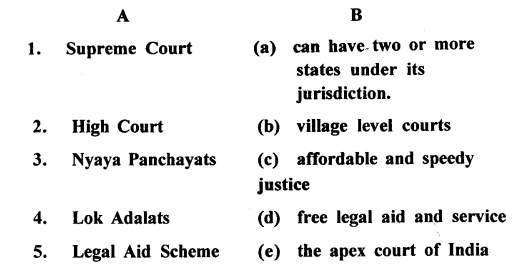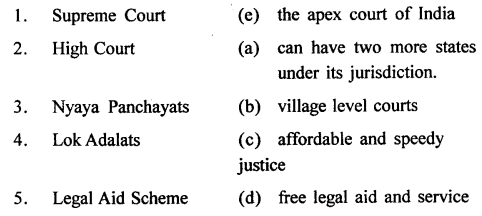The Trail History and Civics for Class 8 ICSE Solutions – The Judiciary
ICSE SolutionsSelina ICSE SolutionsML Aggarwal Solutions
The Trail History and Civics for Class 8 ICSE Answers
Trail HistoryCivics Focus on HistoryCivics GeographyBiologyChemistryPhysicsMaths
EXERCISES
A. Fill in the blanks:
- In India there is a single unified system of courts for the Indian Union and the states.
- The Supreme Court of India is located in New Delhi.
- To quality for the post of a judge in the Supreme Court, a person must either be an advocate of a High Court for at least ten years or a judge of a High Court for five years’ standing.
- The High Court controls and supervises the functioning of subordinate courts.
- The records of the High Court serve as references for lower courts in future cases.
B. Match the following:

Answer:

C. Choose the correct answer:
1. Disputes between the union government and the state government fall under the Original/Advisory/Appellate Jurisdiction of the Supreme Court
Ans. Disputes between the union government and the state government fall under the Original Jurisdiction of the Supreme Court.
2. The District Court/Nyaya Panchayats/Supreme Court has the power of judicial review.
Ans. The Supreme Court has the power of judicial review.
3. The High Court is the highest court of justice in a village/ district/state.
Ans. The High Court is the highest court of justice in a state.
4. Judges of the High Court can serve till they are 60/62/65 years old.
Ans. Judges of the High Court can serve till they are 62 years old.
5. The Nyaya Panchayats/Lok Adalats/District Courts were set up to provide quicker and cheaper judicial services.
Ans. The Lok Adalats were set up to provide quicker and cheaper judicial services.
D. State whether the following are true or false:
- The Chief Justice of the Supreme Court is appointed by the Prime Minister of India.
False. - No cases can be brought directly to the Supreme Court for the first time.
False. - A High Court is not a court of record.
False. - A Nyaya Panchayat can impose a fine of up to ? 10,000.
False. - The process of obtaining justice through law courts is a long-drawn-out and expensive process in our country.
True.
E. Answer the following questions in one or two words/ sentences:
Question 1.
On what grounds can Supreme Court judges be removed from office?
Answer:
Supreme Court judges can only be removed on grounds of proven misbehaviour or incapacity, through impeachment.
Question 2.
Mention any two kinds of disputes that can be brought directly before the Supreme Court.
Answer:
Following cases can be directly brought before the Supreme Court:
- If there are disputes between the Union Government and a State Government or more than one State Government.
- Cases concerning the violation of the Constitution by the Government or an individual.
Question 3.
What is the Advisory Jurisdiction of the Supreme Court?
Answer:
The Supreme Court can advise the President, on request, on legal and constitutional issues. The President may or may not accept the advice.
Question 4.
Why are the records of the cases and judgement of the Supreme Court important?
Answer:
These records serve as references in future cases.
Question 5.
Who appoints the Chief Justice of the High Courts?
Answer:
The President appoints the Chief Justice of the High Court and the other judges in consultation with the Governor of the state and the Chief Justice of India.
Question 6.
What are writs ?
Answer:
A writ is a form of written command, or legal document giving order or direction to a person to act or not to act in a particular way. Some of the writs are the writs of Habeus Corpus, Mandamus, Prohibition, Certiorari, Quo Warranto, etc.
Question 7.
What is a Nyaya Panchayat?
Answer:
Nyaya Panchayat is a small law court at the village level which try petty civil and criminal cases such as trespassing, personal disputes, minor thefts etc.
Question 8.
Why have Lok Adalats been set up?
Answer:
In order to provide quicker and cheaper judicial services, Lok Adalats have been set up.
Question 9.
Why are Lok Adalats becoming popular?
Answer:
Lok Adalats are becoming popular because they provide affordable and speedy justice.
Question 10.
What is the objective of the Legal Aid Scheme?
Answer:
The objective of the Legal Aid Scheme, is to provide free legal aid and legal services to the poorer and weaker sections of the society.
F. Answer the following questions briefly:
Question 1.
The Supreme Court is the highest judicial body in the country. In this context, explain:
(a) Its original Jurisdiction
(b) Its Appellate Jurisdiction.
(c) Why it is called the guardian of the Constitution.
Answer:
(a)
Original Jurisdiction: Certain cases are brought before the Supreme Court directly, for the first time. This happens in cases involving:
- Disputes between the union government and one or more state governments.
- Disputes between two or more states governments.
- Violation of the Constitution by the government or an individual.
- Violation of the Fundamental Rights of an individual.
(b)
Appellate Jurisdiction: The Supreme Court hears appeals against judgements of High Courts. The Supreme Court is the final court of appeal and has power to review and change decisions of the High Court.
(c)
The Supreme Court is the guardian of the Constitution. It safeguards the Constitution in two ways:
- It can cancel a law or an executive order if it is found to violate the Constitution.
- It can issue write (orders or directions) for the enforcement of the Fundamental Rights.
Question 2.
With reference to the powers of the High Court, discuss its:
(a) Original Jurisdiction (b) Appellate Jurisdiction. (c) Review and Revisory Jurisdiction
Answer:
(a)
Original Jurisdiction: A High Court can hear the cases brought for the first time or we can say original cases if they are concerned with disputes regarding Fundamental rights and election petitions.
(b)
Appellate Jurisdiction: A High Court has Appellate Jurisdiction where it can hear appeals against judgements passed in Subordinate Courts. The High Court can review and change decisions taken in the Subordinate Courts.
(c)
The High Court can review and change decisions taken in the subordinate courts. It can also transfer a case from one court to another.
A High Court also controls and supervises the functioning of subordinate courts.
3. In the context of the judicial system in India, answer the following questions:
Question 3(a).
What are the main features of a Nyaya Panchayat?
Answer:
Nyaya Panchayat try petty civil and criminal cases of the village level. They can impose fines upto 100 Rs. only and appeals can be made against decisions taken in the Nyaya Panchayat, to higher courts.
Question 3(b).
Why are Lok Adalats becoming popular in India?
Answer:
Lok Adalats are becoming popular because they provide affordable and speedy justice.
Question 3(c).
Mention the sections of society which receive free legal services under the Legal Aid Scheme.
Answer:
Sections of society who receive free legal services under the Legal Aid Scheme are: ‘
- People belonging to Scheduled Castes, Scheduled Tribes and Other backward classes.
- People who are mentally ill or disabled.
- Women and children.
G Picture study:
This is a picture of the apex indian count.

1. Identify it
Ans. It is Supreme Court of India.
2. What is the composition of this court?
Ans. It has one Chief Justice and a number of other Judges. At Present, the number of Judges including the Chief Justice cannot exceed twenty-five.
3. Who appoints the judges?
Ans. The Judge of the Supreme Court are appointed by the President on the advice of the Council of Ministers and the Chief Justice of India.
4. Explain its role as the guardian of the Constitution.
Answer:
The Supreme Court is the guardian of the Constitution. It safeguards the Constitution in two ways:
- It can cancel a law or an executive order if it is found to violate the Constitution.
- It can issue write (orders or directions) for the enforcement of the Fundamental Rights.